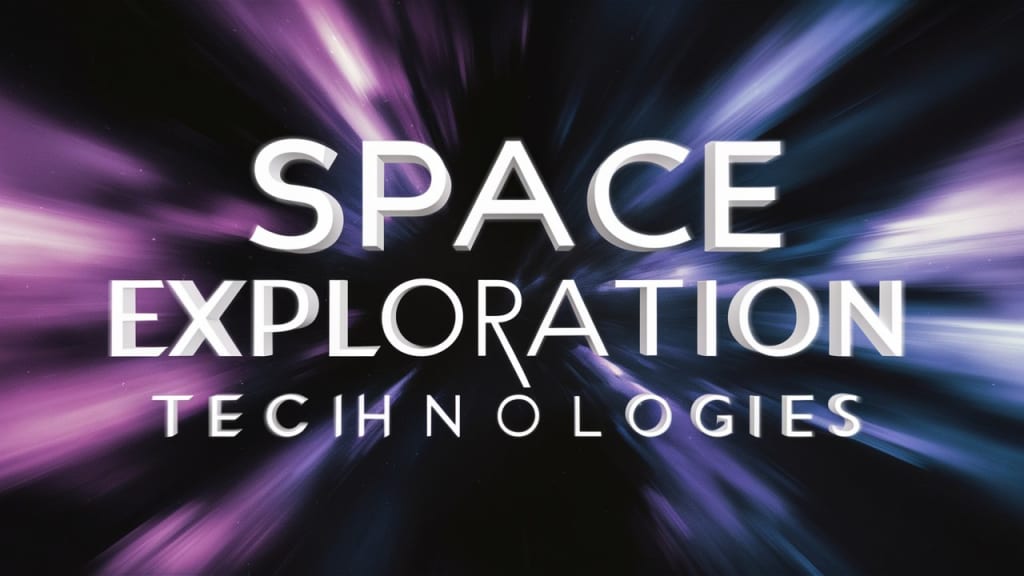Space Exploration Technologies: Pioneering the Final Frontier
How Modern Technology is Transforming Our Journey into Space

Introduction
Space exploration has always been a fascinating topic, capturing the imagination of people around the world. With advancements in technology, what once seemed like science fiction is now becoming a reality. Companies like SpaceX and NASA are leading the way in exploring the final frontier, using cutting-edge technologies to make space travel more efficient, affordable, and accessible. This article will delve into the exciting world of space exploration technologies, exploring how they are changing the game and what the future holds for humanity's journey into space.
Click Here to Connect with Top Dropshipping Suppliers Worldwide!
The Evolution of Space Exploration
From the Space Race to Modern Missions
The history of space exploration began with the space race between the United States and the Soviet Union in the 1950s and 1960s. This period saw significant milestones, such as the launch of Sputnik, the first artificial satellite, and the Apollo missions, which successfully landed humans on the moon. Since then, space exploration has evolved significantly, driven by advancements in technology and a growing interest in understanding the universe.
Early Milestones
Sputnik 1 (1957): The first artificial satellite, launched by the Soviet Union, marked the beginning of space exploration.
Apollo 11 (1969): The first manned moon landing by NASA, with astronauts Neil Armstrong and Buzz Aldrin taking the historic steps on the lunar surface.
Voyager Missions (1977): NASA's Voyager probes provided valuable data on the outer planets and are now traveling beyond our solar system.
Modern Space Exploration
Today's space missions are more ambitious and technologically advanced, with a focus on exploring Mars, studying asteroids, and even planning for manned missions to distant planets. Companies like SpaceX, Blue Origin, and NASA are at the forefront of these efforts, leveraging new technologies to push the boundaries of what is possible.
Key Technologies in Space Exploration
Innovations Driving the Future of Space Travel
Modern space exploration relies on a variety of cutting-edge technologies that enable missions to be more efficient, cost-effective, and safe. These technologies are transforming how we explore space, making it possible to reach farther and achieve more ambitious goals.
Reusable Rockets
One of the most significant advancements in recent years is the development of reusable rockets. Companies like SpaceX have pioneered this technology, dramatically reducing the cost of space travel.
Falcon 9: SpaceX's Falcon 9 rocket is designed to be reusable, with the first stage capable of landing back on Earth for refurbishment and reuse.
Benefits: Reusable rockets lower launch costs, increase the frequency of missions, and reduce the environmental impact of space travel.
Advanced Propulsion Systems
Propulsion technology is critical for space exploration, determining how quickly and efficiently spacecraft can travel.
Ion Thrusters: These engines use ionized gas to generate thrust, providing a more efficient and longer-lasting propulsion method for deep space missions.
Nuclear Propulsion: Research into nuclear propulsion aims to provide faster travel times to distant planets by using nuclear reactions to generate thrust.
Robotics and Automation
Robotic technology plays a crucial role in space exploration, enabling missions to operate in environments that are too dangerous or inaccessible for humans.
Rovers: NASA's Mars rovers, such as Curiosity and Perseverance, are equipped with advanced robotics to explore the Martian surface, conduct experiments, and send data back to Earth.
Robotic Arms: Used on the International Space Station (ISS) and other spacecraft, robotic arms assist with tasks such as repairs, assembly, and scientific experiments.
Artificial Intelligence (AI) and Machine Learning
AI and machine learning are revolutionizing space exploration by enhancing the capabilities of spacecraft and improving mission outcomes.
Data Analysis: AI algorithms analyze vast amounts of data from space missions, identifying patterns and making predictions to assist scientists in their research.
Autonomous Navigation: AI enables spacecraft to navigate and make decisions independently, crucial for missions to distant planets and asteroids.
3D Printing
3D printing technology is transforming how spacecraft and equipment are designed and manufactured, offering flexibility and cost savings.
In-Space Manufacturing: The ability to 3D print components in space reduces the need for carrying spare parts and enables on-demand production of tools and equipment.
Lunar and Martian Bases: 3D printing could be used to construct habitats on the moon or Mars, using local materials to create structures and infrastructure.
Click Here to Connect with Top Dropshipping Suppliers Worldwide!
Exploring the Solar System
Current and Upcoming Missions
With the advancements in space exploration technologies, humanity is embarking on exciting missions to explore our solar system and beyond. These missions aim to answer fundamental questions about the origins of life, the potential for life on other planets, and the nature of our universe.
Mars Exploration
Mars has been a primary focus for space exploration due to its potential for past or present life and its similarities to Earth.
Perseverance Rover: Launched by NASA in 2020, Perseverance is exploring the Jezero Crater, searching for signs of ancient life and collecting samples for future return to Earth.
Mars Sample Return: NASA and ESA (European Space Agency) are collaborating on a mission to bring Martian soil samples back to Earth for detailed analysis.
Moon Missions
The moon remains a critical destination for space exploration, serving as a stepping stone for future missions to Mars and beyond.
Artemis Program: NASA's Artemis program aims to return humans to the moon by 2024, establish a sustainable presence, and prepare for future missions to Mars.
Lunar Gateway: An international collaboration to build a space station orbiting the moon, providing support for lunar exploration and serving as a hub for missions to deeper space.
Asteroid Exploration
Studying asteroids offers insights into the early solar system and the potential for resource utilization.
OSIRIS-REx: NASA's mission to the asteroid Bennu, which successfully collected samples and will return them to Earth for study.
Psyche Mission: Scheduled for launch in 2022, this mission will explore the metallic asteroid Psyche, believed to be the exposed core of a protoplanet.
Beyond the Solar System
Humanity's curiosity extends beyond our solar system, with missions designed to explore distant stars and exoplanets.
James Webb Space Telescope: Set to launch in 2021, this telescope will observe the universe in unprecedented detail, studying the formation of stars and galaxies and searching for habitable planets.
Voyager Probes: Launched in the 1970s, the Voyager probes continue to send back data from beyond our solar system, providing valuable information about the interstellar medium.
The Future of Space Exploration
Challenges and Opportunities
As we look to the future, space exploration promises to bring new discoveries and opportunities, but it also presents significant challenges that need to be addressed.
Human Missions to Mars
One of the most ambitious goals of modern space exploration is sending humans to Mars. This endeavor requires overcoming numerous challenges, including long-duration space travel, radiation exposure, and the need for sustainable life support systems.
SpaceX's Starship: SpaceX is developing the Starship spacecraft, designed to carry humans to Mars and other destinations in the solar system.
Life Support Systems: Advanced life support systems are needed to provide air, water, food, and waste management for astronauts on long missions.
International Collaboration
Collaboration between nations and private companies is crucial for the success of space exploration, pooling resources, expertise, and funding.
International Space Station (ISS): The ISS is a prime example of international collaboration, involving NASA, Roscosmos, ESA, JAXA, and CSA.
Lunar Gateway: The Lunar Gateway project involves multiple space agencies working together to create a sustainable presence around the moon.
Sustainability and Resource Utilization
Sustainable practices and the utilization of space resources are essential for the long-term success of space exploration.
In-Situ Resource Utilization (ISRU): Techniques for using local materials to support missions, such as extracting water from lunar ice or producing fuel from Martian resources.
Space Mining: The potential for mining asteroids and other celestial bodies for valuable resources, reducing the need to transport materials from Earth.
Ethical and Legal Considerations
As space exploration advances, ethical and legal considerations must be addressed to ensure responsible and fair use of space.
Space Debris: Managing space debris and preventing the pollution of space environments is critical for the safety of future missions.
Space Governance: Establishing international laws and regulations to govern space activities and ensure equitable access to space resources.
Click Here to Connect with Top Dropshipping Suppliers Worldwide!
Conclusion
Space exploration technologies are revolutionizing our understanding of the universe and our place in it. From reusable rockets and advanced propulsion systems to AI and 3D printing, these innovations are making space travel more feasible and opening up new possibilities for discovery. As we continue to explore the final frontier, the collaborative efforts of nations and private companies will be essential in overcoming challenges and achieving our ambitious goals. The future of space exploration is bright, promising new insights, opportunities, and the potential for humanity to become a multi-planetary species. With each technological advancement, we take another step closer to unlocking the mysteries of the cosmos and expanding our horizons beyond Earth.
About the Creator
Enjoyed the story? Support the Creator.
Subscribe for free to receive all their stories in your feed. You could also pledge your support or give them a one-off tip, letting them know you appreciate their work.






Comments
There are no comments for this story
Be the first to respond and start the conversation.